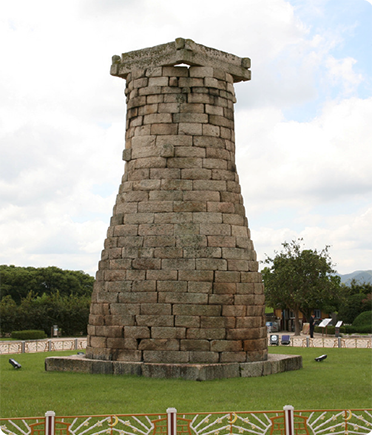Themes
The authors of the first ICOMOS–IAU Thematic Study on astronomical heritage attempted to identify a set of principal themes that spanned the wide range of types of astronomical heritage but nonetheless provided a coherent framework for the development of case studies. In the main, these themes are related to a broad chronology of the major human cultures and to different types of astronomical discovery, knowledge and practice, including but not confined to recognisable stages in the development and use of modern scientific astronomy.

Cheomseongdae observatory, Republic of Korea. Photograph © National Research Institute of Cultural Heritage, Republic of Korea
Recognising that the scope and boundaries of each theme are often unclear, the chosen topics were:
- Earlier prehistory,
- Later prehistoric Europe,
- Pre-Columbian America,
- Indigenous uses of astronomy,
- Ancient and medieval Far East,
- India,
- Mesopotamia and the Middle East,
- Ancient Egypt,
- The Classical World,
- Islamic astronomy,
- Medieval astronomy in Europe,
- Astronomy from the Renaissance to the mid-twentieth century,
- The development of radio astronomy,
- Applied astronomy in modern times,
- Space heritage, and
- ‘Windows to the universe’—starlight, dark sky areas, and observatory sites.
Following the Thematic Study, this portal contains a single thematic essay for each theme, presenting a general overview in accordance with the particular disciplinary competence and experience of the author(s) concerned.
Purpose of the thematic essays
The thematic essays aim to provide a short and clear overview of the recognised evidence relating to astronomical heritage. Thus they provide an initial framework for promoting and supporting the global recognition of astronomical and archaeoastronomical sites of possible significance, including those with potential Outstanding Universal Value (OUV).
Related case studies aim to provide significant examples of methodology in the context of the thematic essay in question.
Structure of the thematic essays
Authors were asked to provide a synthetic overview presenting, as briefly as possible and in broad terms, the astronomical heritage encompassed by their theme. They were invited to address the following main points:
- main facts defining the theme; astronomical/archaeoastronomical context;
- global chronology for the theme; historical and cultural context;
- geographical limits (with a map where possible);
- identification of the main sites and evidence covered by the theme;
- the general state of preservation of the heritage today and the main issues for the zone for conservation;
- present relationships of people/authorities to the sites, perceived value by people and authorities;
- links with other zones, representativeness and influence;
- selected bibliography; and
- illustrative materials (photographs, plans), where these are likely to be of substantial benefit to a reader in understanding the argument.





